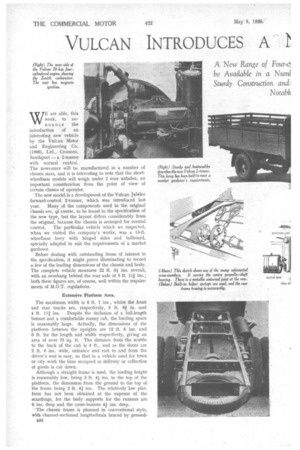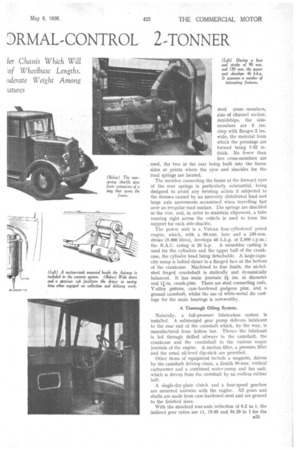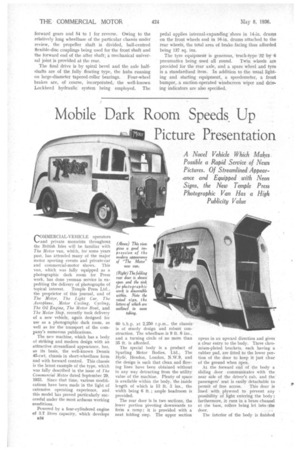VULCAN INTRODUCES A
Page 46

Page 47

Page 48

If you've noticed an error in this article please click here to report it so we can fix it.
DRMAL-CONTROL 2-TONNER WE are able, this week, to announce the introduction of an interesting new vehicle
by the Vulcan Motor and Engineering Co. (1906), Ltd., Crossens, Southport — a 2-tonner with normal control. The newcomer will be manufactured in a number of chassis sizes, and it is interesting to note that the shortwheelbase models will weigh under 2 tons unladen, an important consideration from the point of view of certain classes of operator.
The new model is a development of the Vulcan Jubilee forward-control 2-tonner, which was introduced last year. Many of the components used in the original chassis are, gf course, to be found in the specification of the new type, but the layout differs considerably from the original, because the chassis is arranged for normal control. The particular vehicle which we inspected,. when we visited the company's works, was a 13-ft. wheelbase lorry with hinged sides and tailboard, specially adapted to suit the requirements of a. market gardener.
Before deahng with outstanding items of interest in the specification, it might prove illuminating to record a few of the leading dimensions of the chassis and body. The complete vehicle measures 22 ft. 51 ins, overall, with an overhang behind the rear axle of 5 ft. 111 ins.; both these figures are, of course, well within the requirements of M.O.T. regulations.
Extensive Platform Area.
The maximum width is 6 ft. 7 ins., whilst the front and rear tracks are, respectively, 5 ft. Of in. and 4 ft. 111 ins. Despite the inclusion of a full-length bonnet and a comfortable roomy cab, the loading space is reasonably large. Actually, the dimensions of the platform between the uprights are 12 ft. 8 ins. and 6 ft. for the length and width respectively, giving an area of over 75 sq. ft. The distance from the scuttle to the back of the cab is 4 ft., and as the doors are 2 ft. 6 ins, wide, entrance and exit to and from the driver's seat is easy, so that in a vehicle used for town or city work the time occupied in delivery Or collection of goods is cut down.
Although a straight frame is used, the loading height is reasonably low, being 3 ft. 41 ins, to the top of the platform, the dimension from the ground to the top of the frame being 2 ft. 41 ins. The relatively low platform has not been obtained at the expense of the scantlings, for the body supports for the runners are 6 ins, deep and the cross-bearers 41 ins. deep.
The chassis frame is planned in conventional style, with channel-sectioned longitudinals braced by pressed1332 steel cross-members, also of channel section. Amidships, the sidemembers are 6 ins. deep with flanges 2 ins. wide, the material from which the pressings are formed being 7-32 in. thiCk. No fewer than five cross-members are used, the two at the rear being built into the frame sides at points where the eyes and shackles for the road springs are located.
The member connecting the frame at the forward eyes of the rear springs is particularly substantial, being designed to avoid any twisting action if subjected to the stresses caused•by an unevenly distributed load and large axle movements occasioned when travelling fast over an irregular road surface. The springs are shackled at the rear, and, in order to maintain alignment, a tube running right across the vehicle is used to form the support tor each side-shackle.
The power unit is a Vulcan four-cylindered petrol engine, which, with a 90-mm. bore and a 130-mm. stroke (3.308 litres), develops 46 b.h.p. at 2,400 r.p.m.; the R.A.C. rating is 20 h.p. A monobloc casting is used for the cylinders and the upper half of the crankcase, the cylinder head being detachable. A large-capacity sump is bolted direct to a Ranged face at the bottom of the crankcase. Machined to fine limits, the nickelsteel forged crankshaft is statically and dynamically balanced. It has main journals 214ins, in diameter and 4-in. crank-pins. There are steel connecting rods, Y-alloy pistons, case-hardened gudgeon pins, and a ground camshaft, whilst the use of white-metal die castings for the main bearings is noteworthy.
A Thorough Oiling System.
Naturally, a full-pressure lubrication system is installed. A submerged gear pump delivers lubricant to the rear end of the camshaft which, by the way, is manufactured from hollow bar. Thence the lubricant is led through drilled oilways in the camshaft, the crankcase and the crankshaft to the various major journals of the engine. A suction filter, a pressure filter and the usual oil-level dip-stick are provided.
Other items of equipment include a magneto, driven by the camshaft driving chain, a Zenith 36-mm. vertical carburetter and a combined water-pump and fan unit, which is driven from the camshaft by an endless rubber belt.
A single-dry-plate clutch and a four-speed gearbox are mounted unitwise with the engine. All gears and shafts are made from case-hardened steel and are ground to the finished sizes.
With the standard rear-axle reduction of 6.2 to 1, the indirect gear ratios are 11, 19.65 and 34.29 to 1 for the B33 forward gears and 54 to 1 for reverse. Owing to the relatively long wheelbase of the particular chassis under review, the propeller shaft is divided, ball-centred flexible-disc couplings being used for the front shaft and the forward end of the after shaft; a mechanical universal joint is provided at the rear.
The final drive is by spiral bevel and the axle halfshafts are of the fully floating type, the hubs running on large-diameter tapered-roller bearings. Four-wheel brakes are, of course, incorporated, the well-known Lockheed hydraulic system being employed. The
pedal applies internal-expanding shoes in 14-in. drums on the front wheels and in 16-in, drums attached to the rear wheel, the total area of brake facing thus afforded being 137 sq. ins.
The tyre equipment is generous, truck-type 32 by 6 pneumatics being used all round. Twin wheels are provided for the rear axle, and a spare wheel and tyre is a standardized item. In addition to the usual lighting and starting equipment, a speedometer, a front bumper, a suction-operated windscreen wiper and driving indicators are also specified.




























































































